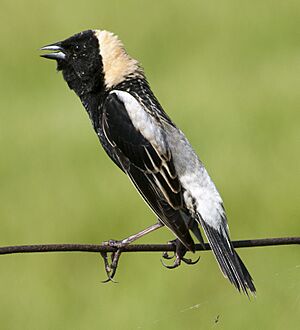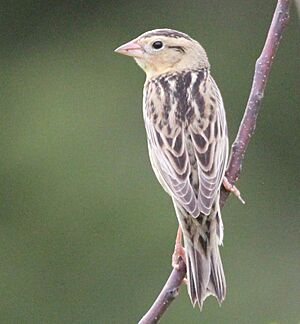Bobolink facts for kids
Quick facts for kids Bobolink |
|
|---|---|
 |
|
| male | |
| Conservation status | |
| Scientific classification | |
| Genus: |
Dolichonyx
|
| Species: |
oryzivorus
|
 |
|
| Approximate distribution. Breeding range Non-breeding range | |
| Synonyms | |
|
|
The bobolink (Dolichonyx oryzivorus) is a small songbird. It belongs to the group called New World blackbirds. It is the only species in its group, called Dolichonyx. People used to call it the "rice bird." This is because it eats grains like rice during winter and when it travels.
Bobolinks spend their summers in the United States and Canada. Most of them live in the northern U.S. during this time. For winter, they fly south to South America. They mostly go to Paraguay, Argentina, and Bolivia. Sadly, the number of bobolinks is quickly going down. This is due to farming changes and losing their homes. They are a threatened species in Canada.
Contents
What's in a Name?
The name Dolichonyx comes from ancient Greek words. Dolikhos means "long," and onux means "claw." The second part of its scientific name, oryzivorus, is from Latin. Oryza means "rice," and vorare means "to devour." This is why it was called the "Rice Bird." The English name "Bobolink" comes from the sound of its song, which sounds like "Bob o' Lincoln."
What Do They Look Like?
Bobolinks are about 16 to 18 centimeters (6 to 7 inches) long. They weigh about 28 grams (1 ounce). They have short, finch-like beaks.
- Length: 15 to 21 cm (5.9 to 8.3 in)
- Weight: 28 to 57 g (1.0 to 2.0 oz)
- Wingspan: 27 cm (10.6 in)
Male bobolinks are mostly black. They have a creamy patch on the back of their neck. Their shoulders, lower back, and rump are white. Female bobolinks are mostly light brown. They have dark streaks on their back and sides. They also have dark stripes on their head. Their wings and tails are darker than their bodies.
Where Do They Live and Travel?
Bobolinks spend their summers in North America. They are found across southern Canada and the northern United States. From 1966 to 2015, their numbers dropped by more than 1.5% each year. This happened across most of their summer homes.
These birds travel very long distances. They fly all the way to southern South America for the winter. One bobolink was tracked flying 19,000 kilometers (12,000 miles) in a year! It sometimes flew up to 1,800 kilometers (1,100 miles) in a single day. Then it would rest for days or weeks.
Bobolinks often travel in large groups. They eat grains from farms, like rice. Because of this, farmers sometimes see them as pests. Even though they fly far, bobolinks are rarely seen in Europe. Most sightings there have been in the British Isles.
In the southern United States, they were called "reedbirds" or "ricebirds." This was because they ate a lot of rice from fields. This happened during their trip south in the fall. One of their main travel routes goes through Jamaica. There, they are called "butter-birds." People used to collect them for food after they got fat from eating rice.
Bobolinks are the only land birds known to fly through the Galápagos Islands every year. These islands are over 2,000 kilometers (1,200 miles) from their main travel path. Charles Darwin even collected a bobolink in the Galápagos in 1835. Scientists think bobolinks might carry parasites that cause bird malaria to the islands. Also, bobolinks in the Galápagos have been found with seeds stuck in their feathers. These seeds are from a plant called Drymaria cordata. This plant is native to the Galápagos but can spread easily elsewhere.
How Do They Live?
Breeding
Bobolinks build their nests in open grassy areas. They especially like hay fields in North America. In good habitats, one male might mate with several females. Females lay five to six eggs in a cup-shaped nest. The nest is always on the ground. It is usually well-hidden in thick grass. Both parent birds help feed the young.
Feeding
Bobolinks look for food on or near the ground. They mostly eat seeds and insects. They are sometimes called the "armyworm bird." This is because they eat many armyworms. This includes the true armyworm and the fall armyworm. They act as a natural way to control these pests. In Florida, bobolinks mostly eat the Fall armyworm. This is because it is more common there.
Calls
Male bobolinks sing bright, bubbly songs while they are flying.
Protecting Bobolinks
In the 1800s, many bobolinks were hunted for meat.
The number of bobolinks is going down. This is mainly because they are losing their homes. Bobolinks are a species at risk in Nova Scotia and across Canada. In Vermont, their numbers dropped by 75% between 1966 and 2007. Originally, they lived in tallgrass prairies and other open areas with thick grass.
Hay fields can be good places for them to nest. But if fields are harvested too early or too often, young birds might not have enough time to grow up and fly away. Waiting just 1.5 weeks longer to harvest hay can help 20% more bobolinks survive. These birds became more common when horses were the main way to travel. This meant more hay was needed.
A study in 2021 looked at American bison being brought back to parts of the United States. It found that this was not good for bobolink numbers. Adult bobolink populations dropped by as much as 62%. Young bobolink populations dropped by up to 84%. This might be because many new bison herds are managed like farm animals. They are often kept in fenced areas and protected from predators. This can lead to too much grazing, trampling, and fast growth of the bison herds. The study also found that if bison grazed lightly, it did not harm the bobolinks. This shows that both species can likely live together if managed correctly.
Gallery







